Search the Special Collections and Archives Portal
Search Results
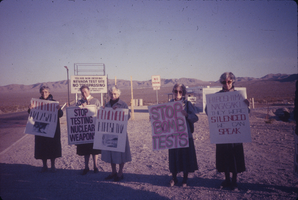
Slide of protesters holding signs near the entrance to the Nevada Test Site, April 1989
Date
1989-04
Archival Collection
Description
Color image of protesters holding signs and standing near the "No Trespassing" sign at the entrance of the Nevada Test Site. They were part of the Lenten Desert Experience, a group opposing nuclear testing.
Image
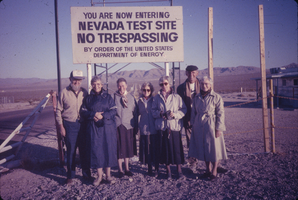
Slide of protesters standing in front of the No Trespassing sign at the Nevada Test Site, April 1989
Date
1989-04
Archival Collection
Description
Color image of protesters standing in front of the "No Trespassing" sign at the entrance of the Nevada Test Site. They were part of the Lenten Desert Experience, a group opposing nuclear testing.
Image
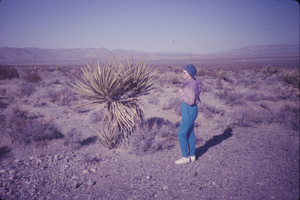
Slide of Sister Rosemary Lynch at a demonstration near the Nevada Test Site, April 1989
Date
1989-04
Archival Collection
Description
Color image of Sister Rosemary Lynch standing near a cactus in the Nevada desert during a demonstration organized by the Lenten Desert Experience, a group opposed to nuclear testing.
Image
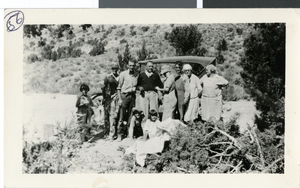
Photograph of Rockwell family members at Mt. Charleston, Nevada, circa 1920s
Date
1920 to 1929
Archival Collection
Description
Description given with photograph: "Mrs. L. A. Rockwell; Earl Rockwell; Leon Rockwell; Bessie Rockwell; (?); (?); Pinky Hayford (?), on end. Below-children. 1920s-at Mt. Charleston."
Image
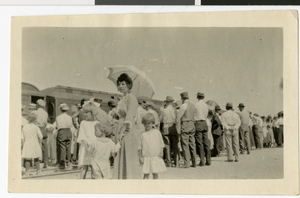
Photograph of World War I draftees at train station, Las Vegas, Nevada, 1918
Date
1918
Archival Collection
Description
People standing outside of railroad passenger cars. Handwritten description from Dave Coons given with photograph: "SP, LA & SL station [street side] with draftees WWI Las Vegas. Sequence of farewell scenes with views of cars. At least one car still lettered 'Salt Lake'." Another description given: "1918 Deen leaving for the army, Las Vegas."
Image
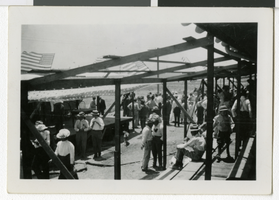
Photograph of a crowded railroad depot, Las Vegas, July 4, 1908
Date
1908-07-04
Archival Collection
Description
Description given with photograph: "4th July - 1908 - speakers stand front Salt Lake RR Freight Depot." Another description given by Dave Coons: "Fourth of July, 1908 at SP, LA, & SL Freight Station, Las Vegas."
Image
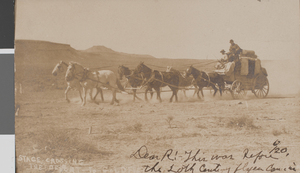
Postcard of a horse-drawn stage coach in the desert, probably in Nevada, circa 1906
Date
1905 to 1906
Archival Collection
Description
Postcard postmaked July 8, 1906 showing men driving a horse-drawn stage coach in the desert, probably in Nevada. Caption: "Stage crossing the desert to Goldfield [Nevada]." Handwritten on photograph: "Dear R: This was before the 20th Century Flyer Co[illegible]" (referring to a steam locomotive).
Image
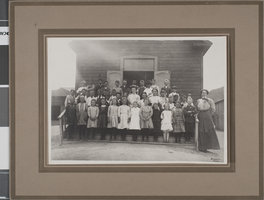
Photograph of children with their teacher outside of a schoolhouse in Tonopah, Nevada, circa 1909
Date
1908 to 1910
Archival Collection
Description
A group of schoolchildren pose with their teacher, Clarice Bateman (at right), in front the elementary schoolhouse in Tonopah, Nevada.
Image
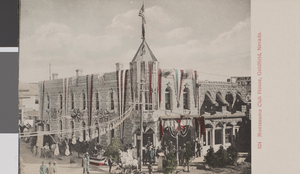
Postcard of the Montezuma Club House, Goldfield, Nevada, circa 1900s
Date
1900 to 1909
Archival Collection
Description
A picture postcard of the exterior of the Elks' Montezuma Club building in Goldfield, Nevada, probably during its grand opening. The building is decorated with flags and banners and a string of electric light bulbs hangs over the street. The building was destroyed by a fire on September 29, 1924.
Image
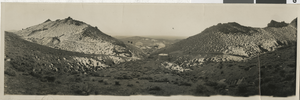
Panoramic photograph of the Antelope quicksilver mining district in Nye County, Nevada, circa 1900s
Date
1900 to 1909
Archival Collection
Description
Panoramic view of the Antelope quicksilver (or mercury) mining district in Nye County, at the south end of the Cactus Range, thirty miles southeast of Goldfield, Nevada.
Image
Pagination
Refine my results
Content Type
Creator or Contributor
Subject
Archival Collection
Digital Project
Resource Type
Year
Material Type
Place
Language
Records Classification
